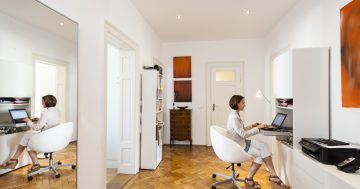
Home workers continue to struggle with poor light, distracting noises and ergonomic issues. Photo: File.
Surveys have found that many remote employees are still dealing with the problems created by the sudden shift to home working caused by the pandemic. Dan Schawbel says it’s high time these are addressed.
Several years after the pandemic forced a mass shift to remote work, many people working from home still don’t have the right set-up.
Research from Logitech finds that most employees are struggling with video, audio or ergonomic issues in their work from home office.
In addition, 64 per cent of workers have poor or inadequate light in their homes, and 58 per cent struggle with distracting noises.
Taken together, these issues could be having an outsized impact on remote worker productivity and engagement.
In fact, a recent study from manufacturing company, Steelcase across 10 countries finds that ergonomic discomfort is a top issue that hurts people’s ability to get their work done from home.
While some organisations took steps to equip their workforce at the onset of full-time remote work, Logitech’s research reveals there’s since been little change in the status quo.
Faced with a lack of support from their employer, workers are trying to understand the challenges they experience working from home, as well as the solutions that might benefit them.
Furthermore, most people are struggling unnecessarily with issues that are fairly easy to solve with today’s business-grade devices.
Here are four steps you can take to improve the work-from-home environment for your team members.
Survey your employees: There’s a good chance your workers may be hesitant to speak up about any challenges they’re facing.
They may think they’ll be singled out for complaining or fear they’ll be seen as ungrateful for their remote work arrangement and be forced back into the office.
Many people are still using tools they grabbed from their office desk and took home during the pandemic. They simply aren’t aware that better tools exist.
I’d recommend doing an anonymous employee survey. Be sure to ask questions about all of the tools and technologies that employees use in their remote work.
It’s also important that you survey workers about noise, lighting, and even clutter, to understand whether other factors could be inhibiting their productivity.
Define organisational requirements: Based on your findings, you’ll need to determine what the next steps will look like.
Any changes you enact will need to meet your budget and security requirements, be compatible with the cloud platform you use, as well as deliver what your employees need to be more productive and comfortable.
Recommend and deploy tools and solutions: A variety of tools can contribute to enhanced performance and comfort for employees’ personal workspaces.
Working with a keyboard and a mouse for long hours involves a lot of repetitive movement.
Having bad posture and the wrong equipment for the job can lead to fatigue, discomfort, and even pain. For users in pain, ergonomic mice and keyboards are a game changer.
Computer speakers, mics, and consumer-grade headsets can make it hard to hear and be heard.
Equipping employees with business headsets and earbuds built for work calls can make a world of difference. Look for options that are lightweight, comfortable and offer noise-cancelling features.
Beyond having great audio, employees also want to be seen clearly. Video problems employees face are largely due to the use of built-in cameras in computers.
High-quality webcams will deliver fantastic image quality, and many also have options for light correction and auto-framing.
With more than three out of four employees suffering from compromised ergonomics, it’s a good idea to invest in ergonomic desk chairs and adjustable desks.
You might also want to communicate with your staff about why working from their sofa or bed is not a good idea, from both a productivity and comfort standpoint.
Bright or day light is often considered the most ideal for home office use.
This light is the least likely to make your eyes hurt or to lead to squinting. It is also a light tone that has been shown to help increase wakefulness and to ward off mid-afternoon sleepiness.
You can also make suggestions to help employees improve other aspects of their home office.
For example, if workers share that they’re struggling with a cluttered workspace, consider a communications campaign around how this can affect their ability to focus and the steps they can take to address this issue.
Iterate and maintain a feedback loop: Although your employees will surely be pleased with an upgraded home office, it’s important to maintain an ongoing feedback loop to understand their evolving needs and preferences.
This will allow you to make adjustments as needed so you can continue optimising their environment.
The needs of the workforce have changed, yet many workers are still trying to get by with a suboptimal home office setup.
Not only is this bad for their personal comfort and wellbeing, tthere’sa good chance iit’sinhibiting their productivity.
Rather than wait for employees to speak up, organisations should be proactive and revisit their home office standards.
You might be surprised by how many of your team members are struggling, and find that even small improvements can greatly improve the remote work experience.
*Dan Schawbel is a bestselling author and managing partner of Workplace Intelligence, a research and advisory firm helping HR adapt to trends, drive performance and prepare for the future.
This article is part of Dan’s Workplace Intelligence Weekly series.










